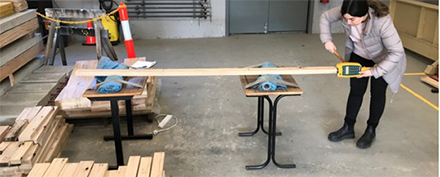Glue laminated timber, glulam, is a highly attractive, versatile structural solution for architects and structural engineers thanks to its ability to achieve long spans and curves, without compromising strength or aesthetic qualities. Source: Timberbiz
Currently, most glulam elements and other engineered wood products worldwide are made using softwoods, like Pinus radiata, however the research team at the University of Tasmania’s Centre for Sustainable Architecture with Wood (CSAW) is currently developing glulam for structural applications using Tasmania’s abundant, plantation hardwood resource.
Funded by the National Institute for Forest Products Innovation (NIFPI) and local Tasmanian timber industry partners, an interesting research project is underway led by Project Chief Investigator Dr Hui Jiao and Project Officer Dr Marcus Noh, which aims to determine the technical feasibility of making glulam elements from fibre-managed plantation Eucalyptus nitens boards.
In Tasmania, much of the available E. nitens plantation resource is fibre-managed, or in other words, unthinned and unpruned during its growth.
There are several challenges with the use of fibre-managed E. nitens sawn board as a glulam feedstock, which this project is investigating. For example, sorting the feedstock for glulam is critical for predicating the strength of the final glulam products.
Because plantation Eucalyptus has not been thinned and pruned, and is harvested at a young age, sawn boards often contain a high percentage of unusual features and characteristics that do not necessarily have the same qualities or behaviours as those in other hardwood timbers.
However, the relevant structural grading standard, ‘AS2082 Timber – Hardwood – Visually stress graded for structural purpose’ (Standards Australia, 2007) makes no allowance for the unusual characteristics of fibre-managed Eucalyptus, and this means that most sawn boards are likely to be discarded as out-of-grade quality if sorted according to the criteria of AS2082. Thus, using the standard visual grading method alone is most likely not enough to help distinguish high-quality plantation E. nitens sawn boards from lower quality ones.
Other relative unknowns when using fibre-managed E. nitens as a glulam production feedstock include the bonding performance of adhesives, design of optimal finger joint geometry, structural performance of the joints, and efficient use of feedstock to achieve reliable glulam grades.
At this stage in the research, a primary goal is to develop a practical and easy rule-of-thumb for sorting plantation E. nitens boards to facilitate glulam production.
Determining the correlation between visual characteristics and the actual structural performance of plantation E. nitens in a non-destructive way is key to successful sorting. Visual characteristics such as knots and checks are being thoroughly examined on a number of specimens at CSAW’s workshop, first on rough sawn, then dressed, and docked boards.
In addition, the acoustic wave velocity generated by an impact to each specimen is measured. This non-destructive evaluation (NDE) method is used regularly with other species, like Pinus radiata, as a quick and economic sorting tool but its applicability to E. nitens requires further investigation.
Finally, the mechanical properties that determine a structural grade such as modulus of elasticity (MOE), modulus of rupture (MOR), and density are assessed using a 4-point bending test in accordance with Australian Standard AS 4063.1.
It is hoped that some correlation between visual characteristics, the acoustic wave velocity and density of fibre-managed plantation E. nitens specimens will shed light on their structural suitability for various aspects of glulam production and support development of an efficient sorting system.
A sorting trial will be followed by delamination tests and finger joint tests in collaboration with researchers at Bern University of Applied Science in Switzerland. It is hoped that this investigation about glulam samples made from Tasmanian plantation E. nitens will pave the way for the timber industry to utilise Tasmanian plantation hardwood resources for high-strength structural members.








